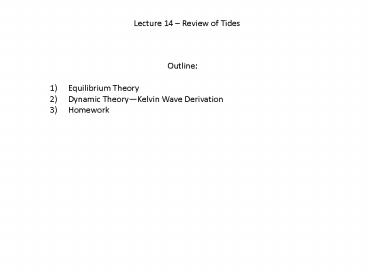Lecture 14 Review of Tides - PowerPoint PPT Presentation
1 / 17
Title:
Lecture 14 Review of Tides
Description:
... every 24 hours because moon is rotating around the earth ... New Moon. Quarter Moon. Quarter Moon. Full Moon. Moon over twice as important for creating tides. ... – PowerPoint PPT presentation
Number of Views:134
Avg rating:3.0/5.0
Title: Lecture 14 Review of Tides
1
Lecture 14 Review of Tides
- Outline
- Equilibrium Theory
- Dynamic TheoryKelvin Wave Derivation
- Homework
2
Tides are the result of the imbalances in
gravitational forces acting on the earth.
Gravitational Force between two objects
G 6.610-11 Newton m2/kg2 M1 mass object
1 M2 mass object 2 r distance between them
Considering only the moon for now
Earth
Common axis of revolution
Moon
r
3
Gravitational force between earth and moon
r
Fm1
Fm2
a
Tide generating force is equal to difference
between the tide gravitational force at the
center of mass of the earth and the gravitational
force at other points
At side of the earth facing moon
So tide generating force is inversely
proportional to the cube of the distance between
earth and moon.
4
Mean force acting between earth and moon
This can be thought of as a centripetal force
(the external force required to make a body
follow a curved path)
F mean centripetal force Fa local attraction
to moon Ft total resulting force
However, nowhere on the earth will the force of
attraction by the moon be exactly equal to the
magnitude and direction of the centripetal force.
On an idealized earth totally covered in water,
this would result in a bulge of water. Bulge
would grow until the pressure gradient associated
with the sloping water surface balanced the total
resulting force.
5
B
A
- Earth is rotating under bulge, so in an ideal
world observer A and observer B would see two
high and two low tides every day. - Tides observed by A would be bigger than those
observed by B. - The same bulge would pass under each observed
every 24 hours and 50.47 minutes. (Not every 24
hours because moon is rotating around the earth
in same direction the earth is rotating) - This is called the M2-tide
6
Still only considering moon.
Apogee
Perigee
Moons orbit around Earth is elliptical not
circular so the size of the bulge will vary with
the moons distance from earth. This has period
of 27.55 days.
7
What about the Sun?
Sun is 27 million times more massive than moon,
but 390 times farther away.
Moon over twice as important for creating tides.
Just like the moon, gravitational force imbalance
due to the Sun creates a bulge of water, but with
a period of 12 hours, instead of 12.42 hours
(M2-moon).
New Moon
Quarter Moon
Quarter Moon
Full Moon
8
Earths rotation about sun is also an ellipse.
January 3
July 7
aphelion
Perihelion
Perihelion to Perihelion occurs in one
anomalistic year (365.2596 days).
Tide generating forces are greater in the
northern hemisphere winter.
9
Interaction between M2 (12.42 hours) and S2
(12.00 hours) gives rise to the spring-neap
variations in tidal amplitude,
10
Declination
So far we have assumed that 1) Moons orbit
around Earth, 2) Earths orbit around the Sun,
and 3) the Earths equator all lie in the same
plane.
However, all of the above are tilted.
Earths axis is tilted 23.5 relative to the
plane of the earths rotation about the sun
Northern Hemisphere Spring
Northern Hemisphere Summer
B
A
Northern Hemisphere Winter
Northern Hemisphere Fall
Observer B now sees two high tides of different
amplitude. This leads to diurnal inequality.
11
Main diurnal and semi-diurnal tidal constituents
12
Equilibrium Theory treats tides on an idealized
Earth covered totally with water (i.e. tides
bulges of water). However, equilibrium theory
usually fails in application.
Earth is not totally covered in water. Tides
interact with the shoreline and bathymetry
Tides propagate as waves under the influence of
rotation
Shallow water waves so
Coriolis turns wave to the right in the northern
hemisphere. Therefore waves propagate with coast
on their right
Kelvin Wave
y
z
x
13
Shallow water waves so
?
h
y
z
x
Governing Equations
Investigate case where u 0
or
This is wave equation, with solution of the form
14
Step 1 Solve for v from continuity
Intermediate solution for v
Step 2 Plug this into x-momentum
Step 3 Require each function to satisfy the
above separately
Defining the Rossby radius of deformation as R
c/f
Gives solutions
This grows exponentially off-shore. Not
realistic. So E2 0.
15
With E20, we now have
Where F is some arbitrary function
For tidal processes we generally assume
Where
Tidal period (T)
Tidal wavelength (L c T)
16
Kelvin Wave Solution
Tidal Elevation (m)
Along-shore distance (m)
Cross-shore distance (m)
Tidal Elevation decays offshore with efolding
length of the Rossby radius
Tides in open ocean are very small (few
centimeters) and the interactions with the shelf
(and in the estuary) determine the near-shore
expression.
17
Homework
- Using t_tide.m perform a harmonic analysis of the
tides in San Francisco Bay and Chesapeake Bay,
data provided on website (SF_CB_tides.txt) - What are the dominant tidal constituents in each
system? - Does equilibrium theory explain these
differences? - Plot the residuals. What do you think drives the
residuals?

